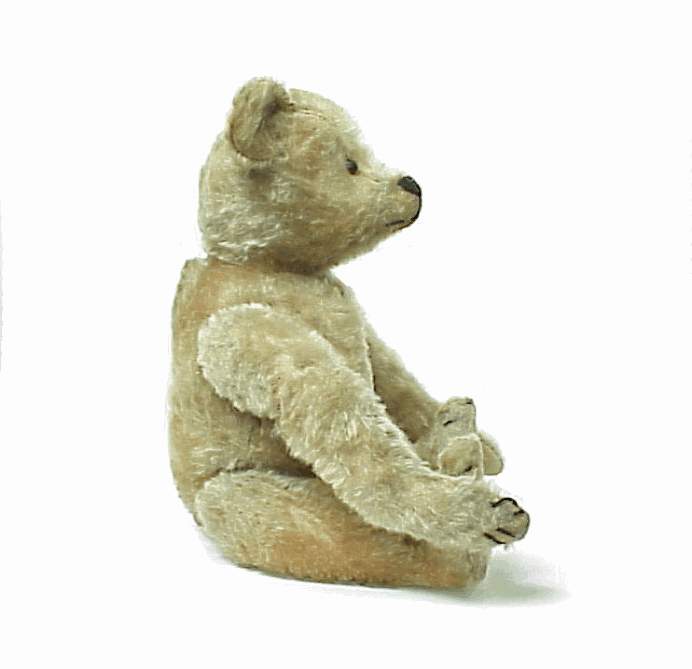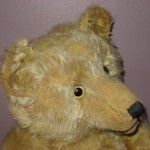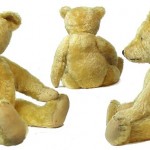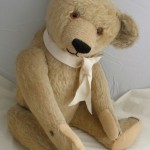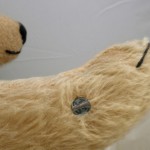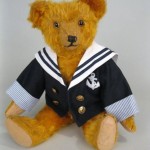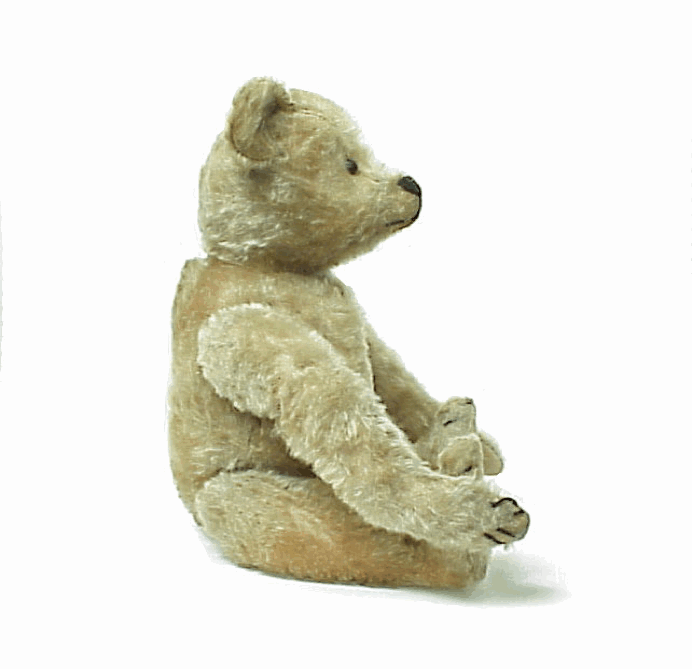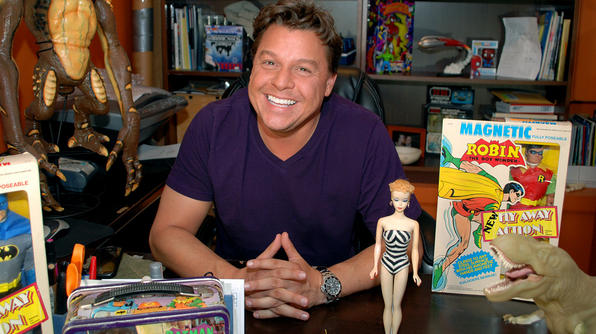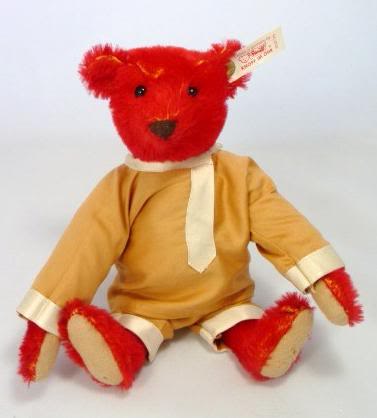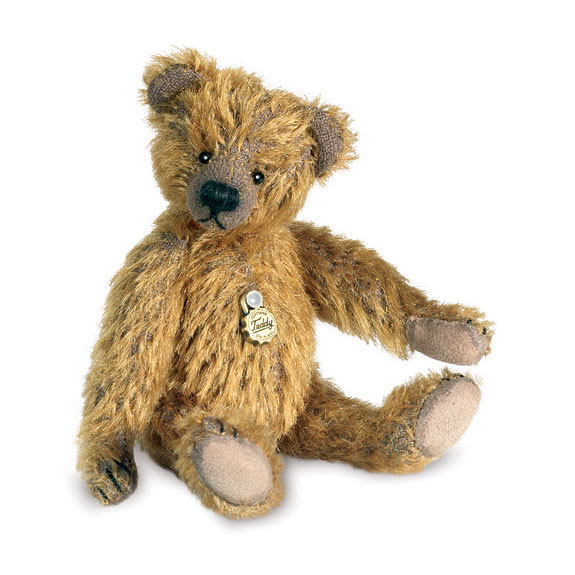Gebruder Bing was founded in Nuremberg in 1865 by Ignaz and Adolf Bing to make tin and kitchenware and later enameled and tin toys around 1890. They made their first bears in 1907 at the height of the teddy bear boom. The first Bing bears had a metal arrow in the ear with the initials G.B.N. set in a diamond. Steiff started litigation against Bing for using the tag in the ear, so Bing put a metal button underneath the arm instead. Steiff still objected to the word “button”, so Bing instead used “G.B.N. label under the arm.” Around 1920, Bing stopped using the tag and replaced it with a metal label attached to the right arm.
Bing is best known for it’s mechanical bears introduced around 1910, very hard to find nowadays. Early Bing teddy bears resembled Steiff bears but changed it’s design around 1920, using a longer snout with distinctive stitching on the muzzle and a very wide smile. Bing stopped producing bears in 1932 but still remain a favorite among collectors.
Bing was famous for mechanical bears, many of them dressed. There were walking bears, skating bears, acrobatic bears and more.
The first mechanical bear was made in 1908 and the clockwork mechanism allowed the head to move from side to side. In 1910 the somersaulting bear was introduced. Steiff claimed it was a copy of their 1909 Purzel Bear and legal action continued until 1915 during which time Bing continued producing their version of the bear. The bear turns somersaults after the arms have been rotated and hangs by chains from a wooden frame.
In 1912 a roller-skating bear was produced, operated by a key under the left arm. The bear moves back and forth while one arm moved up and down, it was made of short bristly mohair and was just 20cm (8″) tall.
In 1913 the footballer bear was introduced with a key in the ball which, when wound up, makes it turn. The wheeled bear’s arm is joined to the ball by a rod and the bear appears to be pushing the ball. Again this bear is just 20cm (8″) high.
Bing did, of course, make many non-mechanical bears. They were all made of high quality material, had lovely expressions on their faces, and are now prized by collectors.
Company History
- 1863 Brothers Ignaz and Adolph Bing founded the Company and it was based in Nuremberg, selling toys and kitchenware. A factory, known as Bing Brothers Nuremberg Toy Factory, was established in the 1880’s to manufacture tin toys.
- 1890 Established a factory in Grunhain, Saxony
- 1895 Became a public limited company, the name changed to Nuremberg Metal and Enamelware Works. Adolph Bing left the company and Ignaz became chairman.
- 1907 Bing began producing plush toys including teddy bears.
- 1908 Legal battle with Steiff re the “button in ear” trademark
- 1909-1912 Neinrich Muller, the founder of Schuco, joined the company. He was trained by Kunz Weidlich the designer.
- 1911 Bing Ltd, operating from East London, became sole agents in Britain (as part of Eisenmann & Co Ltd). A lawsuit with Steiff began, which was to last until 1915, re the somersaulting bear
- 1917 Agents Concentra specialise in marketing all Bing products under different brand names. Bing was the only toy manufacturer to continue production during WWI.
- 1918 Ignaz Bing died
- 1919 L Rees & Co., based in London, act as distribution agents of Bing toys in Britain and Commonwealth. Stephen Bing, Ignaz’s son, becomes director general and the company name was changed to Bing Works.
- 1927 Stephen Bing and all other family members left the company. A variety of reasons are offered ranging from boardroom disagreements to the treatment of Jews (the Bing family were Jewish) by Adolf Hitler.
- 1932 The company went into receivership, equipment was auctioned and parts are sold off, some to rivals such as Karl Bub another Nuremberg toy company, Fleischmann and Schuco.
- 1992 – 1994 In May 1992 Eric Kluge was in the USA on business. He was contacted by an elderly lady called Sarah Neumann, re some teddy bear patterns she owned. That lady was born Sarah Bing. Eric took the patterns and as soon as he returned to Germany he registered the logo and the company “Bing”. In 1994 Gebruder Bing was reborn.
How to Identify Bing Bears
- Pre World War I Bing bears had a metal arrow showing “Bavaria” and the “GBN” in a small triangle. At first the arrow was clipped to the right ear but, after a challenge from Steiff, this was replaced by a “mark” under the left arm. For legal reasons it could not be called a button.

- A silver button, with “GBN” (for Gebruder Bing Nuremberg) incised was used from 1908-1910. As an alternative, some had a red tin button showing “DRPa div. DRGM” which indicated a patent was pending.
- Post 1919 an orange/red circular tag with “Bavaria BW” or “Germany BW” (for Bing Werke) in black were placed on the body and often on the wrist. The colour of this button did vary, a rare white tag was used for a short time in 1919, the orange/red tag was used from 1919 to 1927, blue tags were then used until 1932.
- Early bears were made of mohair, filled with woodwool, had black boot button eyes, humps on their backs did resemble and can easily be mistaken as Steiff bears.
- Stance: early bears, before 1925, larger bears received the name “sentry” because they appear to stand on tip toes. The felt on the foot formed a point toward the heel.
- Bing tended to use only dark brown, gold or white mohair.
- Ears: early bears tended to have small ears, set wide apart almost on the side of the head. As years passed the ears moved to the top of the head.
- Between 1908 and 1910, Bing used an “all in one” ear design on some of it’s non-mechanical bears – the head and ears were cut from a single piece of fabric. These bears are rare and valuable.
- Eyes: black boot button eyes were used until WWI and glass eyes were available to special order, after that glass eyes were used as standard. Glass eyes had a large black pupil and brown or amber painted backs.
- Nose: small bears, less than 16″, had horizontally stitched noses, larger bears had vertically stitched noses. In the 1920’s a shield shape, made up of vertical stitches, with a double stitched border was used which made it easier to distinguish from Steiff bears
- Small bears had squeakers and larger bears (over 10″) had tilt growlers.
Typical Features Of Bing Bears
1907-1915
- Round head
- Small ears set on the side of the head
- Boot button eyes
- Long arms, curved paws
- High quality mohair
- Vertical stitching on bears over 16 inches, horizontal stitching on smaller bears
- Short unshaven muzzle
- Small facial features
- G.B.N. engraved metal button under the arm until 1910
1916-1920′s
- Wide head
- Slightly larger ears set on side of head
- Glass eyes
- Long arms, curved paws
- Quality mohair
- Vertical stitching on bears over 16 inches, horizontal stitching on smaller bears
- Longer muzzle
- Metal tag under the arm, metal label on the body or a limb
1920′s-1930′s
- Very large head
- Very large ears set on top of head
- Orange glass eyes
- Shorter arms, curved paws
- Very long silky mohair
- Distinctive nose stitching on bears over 16 inches with a double stitch that runs under the middle stitches and frames the nose
- Very long shaved muzzle
- Very long smile extending the width of the muzzle
- Orange metal button with B.W. painted in black attached to right arm

